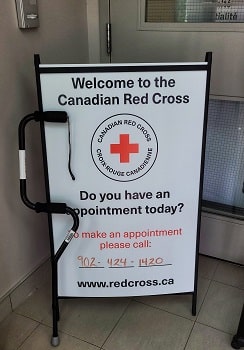Over 6 million people in Canada currently experience disability to the extent that it limits their daily lives. I happen to be one of them.
While most people tend to picture a wheelchair or white cane when thinking about disability, the vast majority of disabilities are, in fact, non-visible.
 |
| Jennifer holding her HELP mobility aid from the Canadian Red Cross in Nova Scotia. Photo courtesy: Jennifer Barnable |
This can include chronic pain conditions, autoimmune illnesses, sensory and cognitive disorders, among many more. Until recently, my disability wasn’t easily apparent either.
Disability doesn’t discriminate
The World Health Organization reports that one billion people globally experience life with disability. Given this reality impacts 15% of our planet’s population, disability is not just an abstract concept that happens to other people.Because disability doesn’t discriminate, it can appear in our lives, whether from birth, through illness and injury, or simply by the natural process of aging. Chances are, you or someone you know, lives with some form of temporary or permanent disability.
Would you know where to turn to if you needed health equipment to maintain your quality of life?
Red Cross Health Equipment Loan Program provides support to community
Last summer, when I worked with the Canadian Red Cross, my mobility was beginning to change. Back then, I wrote about my experience with requiring adapted first aid training. At the time, I didn’t realize I would be turning to the Red Cross once again to support my needs.Today, I’m now a Red Cross volunteer and a community member who receives their support services through another important program. My disability has continued to change to the point where one of my healthcare providers recently recommended I try a mobility aid. Although it was something I’d never envisioned, I agreed and was referred to the Red Cross Health Equipment Loan Program (HELP).
 Through HELP, the Red Cross provides aids ranging from bath chairs and walkers to IV poles and wheelchairs, just to name a few.
Through HELP, the Red Cross provides aids ranging from bath chairs and walkers to IV poles and wheelchairs, just to name a few.Access to this reputable and safe program comes via a health authority referral or from a regulated and registered community care provider like a physician, registered nurse or LPN, chiropractor, or physiotherapist.
I took the short-term loan option, which supports people recovering from injury or illness, or experiencing mobility issues for up to three months.
A clear benefit of participating in this program is the opportunity to remain independent and engaged in daily life through the use of health equipment. HELP also assists people in leaving hospital earlier to begin their recovery at home, or, in the case of palliative care, enables them to spend their last days at home. Dignity is central to this Red Cross program.
Available in seven provinces and territories across Canada, HELP operates in Newfoundland and Labrador, Nova Scotia, Prince Edward Island, New Brunswick, Alberta, British Columbia and the Yukon.
A smooth and supportive HELP experience in Nova Scotia
After a referral form, like a prescription, was sent off to the Canadian Red Cross office in Dartmouth, Nova Scotia, I received a phone call a few days later as part of the consultation process. The Red Cross volunteer took time to discuss how HELP works, carefully confirmed my details, and paired me up with a piece of available equipment to suit my mobility needs.Within a week, I was at my appointment to pick up the mobility aid loan. As I arrived at the Dartmouth Red Cross office, I saw the cane waiting for me at the contactless pick up point inside the main entrance. My name was attached to it, along with a useful instructions guide. I’ve never used a crutch or cane before, so this was very practical.
As I lingered there trying to figure out if the cane’s height was correct for me, a Red Cross staff member quickly came out and greeted me, offering assistance. They performed a quick and efficient check of the cane, making a quick height adjustment for me and ensuring it was secure.
It took mere minutes and was professional, friendly, and dignified. I was impressed! I also very much appreciated the contactless pick up option, and the physical distancing and masking protocols in place. People with disabilities and illnesses are at a much increased risk of impact from COVID-19 and I was relieved to see that my health and wellbeing was important to them.
Could you benefit from Red Cross HELP?
Because I had worked with the Canadian Red Cross before, I had already become familiar with HELP before it turned out I would later need it. I’m fairly certain that, otherwise, I wouldn’t have been aware it existed. As a person with a disability, HELP is bridging a gap for me as I wait for a customized mobility aid to arrive. It gives me a chance to learn how a cane works and how to safely walk with one on those days I need that support.
Most importantly, a mobility aid loan provides me with independence and security, allowing me to continue to be active and participate in my community. I never imagined I’d become disabled or need a mobility aid, but I’m grateful the Red Cross was there for me when I did.
Consider the people in your community who could benefit from this program. Who comes to mind?
Here in Nova Scotia, a recent report indicates that almost 230,000 people identify as living with disability. I was surprised to learn that, for such a small province, it has the highest rate of disabled citizens across Canada, at 30% (about 8% higher than the national average). Considering these statistics, it’s clear that HELP would be much needed and appreciated here in this part of the country, as well as elsewhere this important program is offered.
Thanks to those who support the Canadian Red Cross, people like me can continue to enjoy our lives, contribute to our communities, and feel a sense of belonging.
To check if the Health Equipment Loan Program is offered in your area and to learn more about it, visit the Canadian Red Cross “In Your Community” resource page. Please reach out if you have health equipment you’d like to donate to help others in your community.
Related stories:

